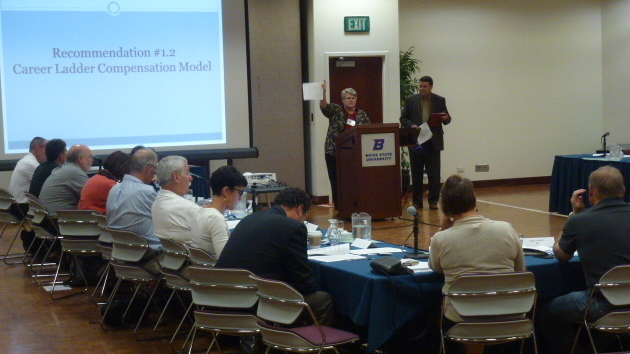During the recession, Idaho’s public school budget cuts were among the deepest in the nation.
And while Idaho’s 2013-14 public school budget included a $28.6 million increase, the added money merely kept pace with inflation and enrollment growth.
These are two findings from a national study, released this month by the Center on Budget and Policy Priorities, a Washington, D.C., nonprofit think tank.
The center’s reports put Idaho’s K-12 cuts into national perspective; Idaho is among at least 34 states that are spending less per pupil than they did in 2008-09. And the report comes just as Idaho education stakeholders are making a concerted push to reverse K-12 budget cuts — with initial support from Gov. Butch Otter and Superintendent of Public Instruction Tom Luna.
Key findings
The report charted one- and six-year educational budget trends:
- When adjusted for inflation, Idaho’s per-pupil spending has dropped 15.9 percent since 2007-08, the eve of the recession. Only four states made deeper cuts: Oklahoma, Alabama, Arizona and Kansas.
- In terms of raw dollars, adjusted for inflation, Idaho is spending $930 less per student than it did in 2007-08. Again, this is among the sharpest declines in the nation, exceeded only by Alabama, Wisconsin and Kansas.
- As the economy has improved, 29 states have increased per-pupil spending from 2012-13 to 2013-14 — although some of these increases are modest and have not made up for previous cuts. When adjusted for inflation, Idaho’s per-pupil spending remained unchanged from 2012-13.
In 2013, legislators and Otter agreed on a $1.3 billion general fund budget for K-12 — still $59 million less than the 2007-08 budget.
It’s the third straight year Idaho has increased its public schools budget, and the 2013-14 budget represents a 2.3 percent increase from 2012-13. However, much of this year’s budget increase has been earmarked for one-time initiatives, such as merit pay and technology pilot projects. And this week, Luna said the state’s overall enrollment exceeded 290,000 for the first time — an increase of nearly 3,000 from fall 2012-13.
Next steps?

There are signs that Idaho may reverse the spending cuts.
A broad-based 31-member education reform task force, appointed by Otter, issued a list of 21 recommendations in August. The recommendations include a $253 million teacher career ladder program and a push to equip schools with WiFi and broadband and teachers and students with what the group called “technology devices.”
One of the task force’s recommendations speaks directly to the recession-era budget cuts. The task force wants Otter and the Legislature to restore $82.5 million in school district “operational funding,” restoring these budgets to pre-recession levels. In 2008-09, districts received $25,000 per classroom in “operational funding,” sometimes called “discretionary funding.” That figure is now $20,000 per classroom.
By either name, districts and school trustees funnel this funding into a long list of items, from insurance benefits to heating and utilities to transportation.
Luna is a member of the task force, which unanimously supports restoring the operational funding. “It is important to note that these (task force) recommendations were not only for restoring operational funds but also for changes to the funding formula and the way teachers are paid,” Luna spokeswoman Melissa McGrath said Friday.
Otter has also voiced his support for restoring operational funding, although he has said it might take several years to finish the job. And in an interview Wednesday with the Idaho Statesman’s Dan Popkey, Otter indicated that the money might come with some strings attached.
“If we weren’t spending that $82 million correctly in the first place I don’t want it to go right back into the same environment. I want to create some expectations for that $82 million going back and I think that’s what the task force expects me to do.”
Far-reaching impacts
But even if Idaho and other states restore education spending, the Center on Budget and Policy Priorities report suggests that the results of the recession-era cuts will linger for years.
The cuts have had a profound effect on communities and local economies, says the center, a think tank that focuses on budget decisions and their impact on low-income Americans. Across the nation, 324,000 teaching jobs have been cut since 2008, with many other teachers facing pay cuts or furloughs.
School districts have had little recourse but to make up for state budget cuts by seeking local property tax increases — even in the face of a “precipitous” decline in property values, said report authors Michael Leachman and Chris Mai. In Idaho, voters have approved more than $195 million in school property tax levies so far in 2103; most are supplemental levies designed to backfill day-to-day budgets.
The budget cuts also have undermined a variety of educational reform efforts — including efforts to hire and retain quality teachers and reduce class sizes.
“To prosper, businesses require a well-educated work force,” said Leachman and Mai. “The deep education spending cuts states have enacted will weaken that future work force by diminishing the quality of elementary and high schools. At a time when the nation is trying to produce workers with the skills to master new technologies and adapt to the complexities of a global economy, large cuts in funding for basic education undermine a crucial building block for future.”
